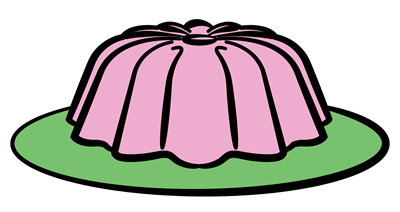In Dante’s Paradiso, he describes nine spheres of heaven. The seventh is for the contemplatives, people who dedicated their lives to ascetic contemplation; as a reward, they get to live on Saturn.
And, according to Del Monte, the seventh heaven also has pineapple pudding.
- 2 pkgs. vanilla tapioca pudding
- 4 cups milk
- 2 envelopes unflavored gelatine
- 1/2 cup cold water
- 2 egg whites
- 3 tablespoons sugar
- 1/2 cup moist shredded coconut
- 1 No. 2 can DEL MONTE Pineapple Chunks
- 4 to 6 maraschino cherries, sliced
- Make pudding with milk according to package directions.
- Soften gelatine in the cold water; stir into hot pudding.
- Beat egg whites till frothy, continue beating, while adding sugar a teaspoon at a time, till mixture stands in soft peaks.
- Stir pudding mixture into egg whites. Pour into 2-qt. mixing bowl. Chill 6 to 8 hrs.
- At serving time, unmold and sprinkle with coconut. Arrange drained CHUNKS and cherry slices on top and around mold.
Contemplate the pudding.
Contemplate the softening gelatin.
Contemplate some whipped egg whites and then contemplate… er, fold them all together.
This looked distinctly blotchy when unmolded, thanks to the tapioca. There were also a couple of weird patches that could have been either gelatin not fully mixed in, or big tapioca lumps. I contemplated them for a while and then just put coconut and pineapple and cherries all over it.
“I’m sorry, am I supposed to eat this entire pudding?”
“If you like it, sure.”
“Can I have it in a bowl?”
“Huh.”
“What? I thought it would be pretty good from tasting while cooking.”
“It’s just really… vanilla. Oh, wait, I know a way to make this better.”
I waited in the dining room, puzzled, as he went into the kitchen — and returned with a bottle.
The rum helped slightly, but it still just wasn’t very interesting.
Verdict: Sweet, but not very interesting.
Tasting notes:
This is called pineapple pudding despite a distinct lack of pineapple, and as soon as you get under the fruit and coconut it’s just plain vanilla… literally. It looked beautiful and completely failed to live up to that potential. A splash of rum made it slightly interesting, but not enough.













Yo ho ho and a bottle of rum, splash it on the pudding and into the tum! Ten points to Buzz for resourcefulness! A theme seems to be developing with your Sunday guest recipes: blandness. I can attest from bland personal experience that blandness was one of the main, if not the main, characteristic of mid-century cooking. My parents thought (and still think in their golden years) that green bell pepper is enormously exotic. Garlic was (and is) avoided as if it were a deadly poison. The only jar of spice I can remember in the cupboard was cinnamon, used on cinnamon sugar toast. Salt and pepper were it, and we were always being warned to be careful with the pepper. There is a funny old Andy Griffith episode from the 1960s in which Andy, through a series of misunderstandings, ends up eating three spaghetti dinners at three different houses in one evening. At each house, the cook reveals that the secret ingredient in the sauce is “a Greek spice called oregano,” spoken in almost hushed tones and thought to be incredibly daring. I wonder what accounted for the drab and colorless mid-century palate. In Britain, post-war rationing was mostly to blame, but what could have brought it about here in the U.S.? Perhaps it’s related to all the new commercial products and mixes (and the recipes designed for them), which were clearly tailored to appeal to the largest potential pool of consumers.
I think there simply wasn’t any spicy Anglo-American food at all — I’d blame the Brits MUCH further back than rationing. Thanks to increased immigration and ingredient availability, modern consumers have totally different expectations. It’s an epic culinary shift from the mid-century.
I’m personally glad to be living now and only having to endure the blandness when I visit the past through my kitchen! 😀
It’s certainly true that British food had started to turn bland earlier and that rationing merely accelerated it. In Colin Spencer’s “British Food: An Extraordinary Thousand Years of History” (Columbia University Press, 2002), he lays the blame on industrial food production in the 19th century and shows that British food had actually been anything but bland and tasteless from the 18th century on back. If his thesis is correct, then that would accord with America’s post-war love affair with the bland, a time, like 19th-century Britain, when industrial, processed, ready-made food was widely affordable and popular.
I think the reputation of Anglo-American food as uniformly bland rests most comfortably on the shoulders of the white bourgeoisie. The Indian influence would have brought some spice to Britain as early as the late 19th century. Many ethnic and regional traditions in the U.S. included spicier dishes as well (think cajun and New Orleans), though, again, as with Indian influences in Britain, most of the white middle-class wouldn’t have partaken. My own grandmother, who came of age in the 1920s and was a good home cook, used many more spices than my mother and even grew herbs in her garden for use in cooking. My mother’s generation turned against that and embraced the bland, processed foods of their generation (1950s/60s). I sometimes think my mother was deliberately a bad cook as a way of rebelling against her mother.
My mother was a terrible cook in much the same way, and probably for a similar reason…
There’s always been a strong nativist element among Anglo-Americans, and lots of spicy cuisines are associated with immigrant groups (garlic with Italians, chile peppers with Mexicans, etc.). I wonder if distrust of anything immigrant is behind some of the blandness.
You know what really gets me with this?
Pineapple chunks come in juice. Replace the water for the gelatin with the juice and, while probably still a bit sweet, it would have a lot more pineapple taste.